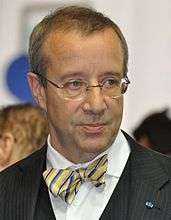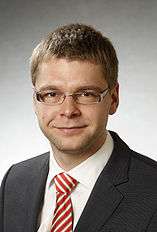Social Democratic Party (Estonia)
The Social Democratic Party (Estonian: Sotsiaaldemokraatlik Erakond, SDE) is a social-democratic[2][3] political party in Estonia, currently led by Indrek Saar.[6]
Social Democratic Party Sotsiaaldemokraatlik Erakond | |
|---|---|
| Leader | Indrek Saar |
| Founded | 8 September 1990 (as ESDP) |
| Headquarters | Toompuiestee 16, Tallinn 10137 |
| Youth wing | Young Social Democrats |
| Membership (2019) | |
| Ideology | Social democracy[2][3] Pro-Europeanism[4] |
| Political position | Centre-left[5] |
| European affiliation | Party of European Socialists |
| European Parliament group | Progressive Alliance of Socialists and Democrats |
| Colours | Red |
| Riigikogu | 10 / 101 |
| European Parliament | 2 / 7 |
| Website | |
| www | |
The party was formerly known as the Moderate People's Party (Estonian: Rahvaerakond Mõõdukad).[7] The SDE has been a member of the Party of European Socialists since 16 May 2003 and was a member of the Socialist International from November 1990 to 2017.[8]
History
1989–today
For the history of Estonian Social Democracy before the 1980s, see Estonian Social Democratic Workers' Party
During the perestroika era the Estonian Social Democratic Party (Eesti Sotsiaaldemokraatlik Partei, ESDP) was formed as Estonia's social-democratic movements merged in 1990. The movements were: the Estonian Democratic Labour Party, the Estonian Social Democratic Independence Party, the Russian Social Democratic Party of Estonia and the Estonian Socialist Party's Foreign Association (successor of Estonian Socialist Workers Party in exile). The ESDP's first leader was Marju Lauristin. They restored their contacts with the Socialist International in 1990. ESDP formed an electoral alliance with the agrarian Estonian Rural Centre Party (formed in 1990) for 1992 and 1995 elections. In 1996, after electoral defeat these two parties finally merged and named themselves the Moderates (Mõõdukad). The Moderates were accepted as a full member of the Socialist International at its 20th congress in September 1999.[9]
In 1999 the Moderates and the centre-right People's Party, set up in May 1998 after a fusion of Peasants' Party and People's Party of Republicans and Conservatives (a 1994 splinter group from the Fatherland Alliance), formed the Moderate People's Party (Rahvaerakond Mõõdukad). The seemingly unlikely decision to fuse took place on 29 May 1999, with some foreign commentators drawing parallels with 'right-wing socialists'.[10] In November the same year, the unification was formally approved by party's general assembly.
The Moderates' contacts with People's Party predecessors had started in 1998. The two parties had a joint list in 1999 parliamentary election and formed a governing coalition with Pro Patria Union and Reform Party. In 2003, the Moderate People's Party joined the Party of European Socialists. After disappointing election results in 2003, the party renamed itself the Social Democratic Party (SDE) on 7 February 2004.
It was the most successful party in the 2004 European Parliamentary Election, obtaining 36.8% of the national vote (most of which went to their leading candidate Toomas Hendrik Ilves) and returning 3 MEPs.
The SDE is committed to the social market economy model, in addition to conventional social-democratic values including equality, social justice, solidarity, and the welfare state. On 10 May 2005 former social-liberals Peeter Kreitzberg and Sven Mikser joined them. On 28 November former social-liberal Mark Soosaar re-joined the SDE. The party was in opposition from 2002 on, but they participated talks for a common alternative presidential candidate to Arnold Rüütel, SDE's Toomas Hendrik Ilves was elected on 23 September 2006 as the next president of Estonia (apart from the Social Democrats, he was supported by the Reform Party of Estonia, Pro Patria Union and Res Publica deputies).
After last elections to the local government councils on 16 October 2005, the party in most major cities is in opposition, but are a part of the governing coalition in Rakvere and Tapa. The party improved its position in most areas. In Tallinn, it formed a joint list with the agrarian People's Union, which got 6 seats out of 63 seats with 11.1% share of votes. Comparing to 2003. elections to the local government council in Tallinn SDE and People's Union gained seats. In the 2003 election, SDE got a 4.9% share of votes and People's Union 3.4% share of votes, which were both below a 5% election threshold. In Estonia, SDE local lists won 6.43% share of votes. In 2003 they got only 4.39% share of votes nationally. SDE is today represented on 65 local councils out of 206 and is governing in 20 local councils. After the 2003 election the party was represented in 104 local councils out of 247.
SDE's aim in the 2007 Estonian parliamentary election was to win at least 17 seats out of 101. Independent member of current Riigikogu Liina Tõnisson ran as a candidate in their list. All SDE's MEPs and their current MPs were candidates in the 2007 election. The party got 58,354 votes (10.6% of the total), a gain of +3.6%; it won 10 seats in the new Riigikogu, a gain of four.
In April 2007, the Social Democrats joined the coalition government led by the Estonian Reform Party.
In the 2011 parliamentary election on 6 March 2011, the SDE received 17.1% of the vote and 19 seats.
The small Russian Party in Estonia merged into the SDE in 2012.
Following the resignation of Prime Minister Andrus Ansip, a new cabinet was sworn in on 26 March 2014, with Taavi Rõivas of the Reform Party serving as Prime Minister in coalition with the SDE.[11]
In the 2014 European elections held on 25 May 2014, the SDE won 13.6% of the national vote, electing a single Member of the European Parliament.[12]
In the 2015 parliamentary election on 1 March 2015, the SDE received 15.2% of the vote and 15 seats in the Riigikogu.[13] After the coalition formation with Reform and IRL, MP Jevgeni Ossinovski announced that he would challenge Sven Mikser in the party congress on 30 May 2015.[14] Mikser however stepped down before the election at the congress and Ossinovski was chosen as the new party leader.[15] On 7 November 2016, the Social Democratic Party and IRL announced that they were asking Prime Minister Taavi Rõivas to resign and were planning on negotiating a new majority government.[16] In the following vote of confidence on 9 November, the majority of Riigikogu voted in favor of removing the prime minister's government.[17]
On 23 November 2016, a new coalition government consisting of the Estonian Centre Party, SDE and IRL was sworn in.[18]
Leaders of the Party

- Marju Lauristin 1990–1995
- Eiki Nestor 1995–1996
- Andres Tarand 1996–2001
- Toomas Hendrik Ilves 2001–2002
- Ivari Padar 2002–2009
- Jüri Pihl 2009–2010
- Sven Mikser 2010–2015
- Jevgeni Ossinovski 2015–2019
- Indrek Saar 2019–
Electoral results
Parliamentary elections
| Election | Votes | Seats | Pos. | Government | Notes | |||
|---|---|---|---|---|---|---|---|---|
| # | % | ± pp | # | ± | ||||
| 1992 | 44,577 | 9.7 | 12 / 101 |
12 | 4th | Coalition | as Moderates (joint list with Rural Centre Party) | |
| 1995 | 32,381 | 6.0 | 6 / 101 |
5th | Opposition | as Moderates (joint list with Rural Centre Party) | ||
| 1999 | 73,630 | 15.2 | 17 / 101 |
4th | Coalition (1999–2002) |
as Moderates (including People's Party candidates) | ||
| Opposition (2002–2003) | ||||||||
| 2003 | 34,837 | 7.0 | 6 / 101 |
6th | Opposition | as Moderate People's Party | ||
| 2007 | 58,363 | 10.6 | 10 / 101 |
4th | Coalition (2007–2009) |
|||
| Opposition (2009–2011) | ||||||||
| 2011 | 98,307 | 17.1 | 19 / 101 |
4th | Opposition (2011–2014) |
|||
| Coalition (2014–2015) | ||||||||
| 2015 | 87,168 | 15.2 | 15 / 101 |
3rd | Coalition | |||
| 2019 | 55,349 | 9.8 | 10 / 101 |
5th | Opposition | |||
Periods in Government
1992–1994, 1994–1995, 1999–2002, 2007–2009 they participated in three centre-right governments with today's Fatherland Union and Reform Party. Social democrats were in government in 1992–1994 Mart Laar's first government, in 1994–1995 Andres Tarand's government (often called to Christmas Peace government (jõulurahu valitsus)) and in 1999–2002 Mart Laar's second government (often called Triple Alliance (kolmikliit)) and from 2007 to 2009, when the Social Democrat ministers were expelled from the government.
Members of Estonian Parliament (Riigikogu)

MP, electoral district [19]
- Jevgeni Ossinovski, Keslinn, Lasnamäe and Pirita, chairman of fraction
- Riina Sikkut, Haabersti, Põhja-Tallinna and Kristiine, vice-chairman of fraction
- Marina Kaljurand, Harju- and Raplamaa
- Kalvi Kõva, Võru-, Valga- and Põlvamaa
- Helmen Kütt, Järva- and Viljandimaa
- Sven Mikser, Haabersti, Põhja-Tallinna and Kristiine
- Ivari Padar, Võru-, Valga- and Põlvamaa
- Heljo Pikhof, Tartu city
- Katri Raik, Ida-Virumaa
- Indrek Saar, Lääne-Virumaa
Symbols
 logo of the Moderate People's Party
logo of the Moderate People's Party logo until 2016
logo until 2016 logo 2016–
logo 2016–
See also
- Social Democratic Party
- Estonian Social Democratic Workers Party (historical)
References
- "Äriregistri teabesüsteem" (in Estonian). Retrieved 1 January 2019.
- Nordsieck, Wolfram (2019). "Estonia". Parties and Elections in Europe.
- Dimitri Almeida (2012). The Impact of European Integration on Political Parties: Beyond the Permissive Consensus. CRC Press. p. 71. ISBN 978-1-136-34039-0. Retrieved 14 July 2013.
- https://www.sotsid.ee/erakond/programm-2015-aasta-riigikogu-valimistel/
- Kroet, Cynthia (8 April 2015). "Estonian coalition partners present cabinet line-up". Politico Europe.
- "OTSE: sotsiaaldemokraadid valisid erakonna esimeheks Indrek Saare". ERR. Retrieved 9 June 2019.
- James C. Docherty; Peter Lamb, eds. (2006). Historical Dictionary of Socialism. Scarecrow Press. p. 119. ISBN 978-0-8108-6477-1.
- http://www.histrodamus.ee/index.php?event=Show_event&event_id=2659&layer=170&lang=est#2659
- http://www.socialistinternational.org/viewArticle.cfm?ArticlePageID=54
- Right-wing Socialists. An unlikely merger, Mel Huang, Central Europe Review, Vol 0, No 37, 7 June 1999
- http://www.globalpost.com/dispatch/news/afp/140326/estonia-swears-eus-youngest-pm-taavi-roivas
- http://ep2014.vvk.ee/voting-results-en.html
- http://rk2015.vvk.ee/voting-results.html
- "Ossinovski decides to run for leader of Social Democrats". ERR. 12 May 2015. Retrieved 12 May 2015.
- "Ossinovski valiti sotside uueks juhiks, Mikser loobus". Postimees. 30 May 2015. Retrieved 30 May 2015.
- "Government falls as Social Democrats and IRL leave coalition". ERR. 7 November 2016. Retrieved 7 November 2016.
- "Prime Minister loses no confidence vote, forced to resign". ERR. 9 November 2016. Retrieved 9 November 2016.
- "49th cabinet of Estonia sworn in under Prime Minister Jüri Ratas". ERR. 23 November 2016. Retrieved 23 November 2016.
- "Riigikogu valimised 2019". Vabariigi Valimiskomisjon. Retrieved 8 April 2019.
External links
- http://www.sotsdem.ee Official website
- https://web.archive.org/web/20061129214423/http://www.noorsots.ee/ Social Democratic Youth in Estonia